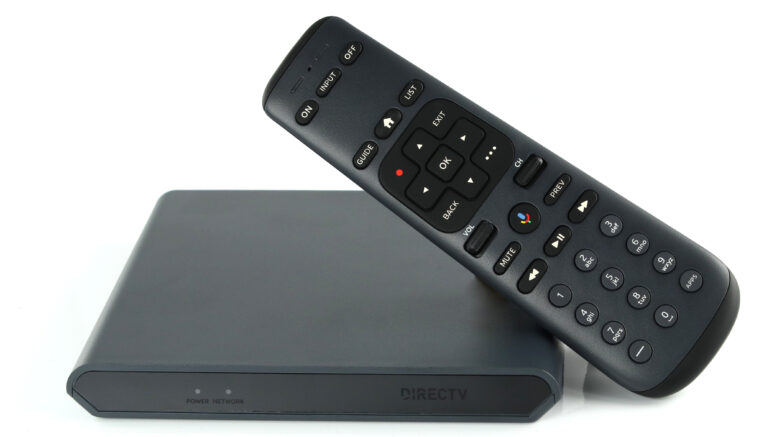Even though it’s been with us for almost a year, people are still discovering DIRECTV’s Gemini for Satellite. DIRECTV has been hitting it out of the park with new products and services, and perhaps none is as popular as its Gemini series. There’s the satellite version, linked above, and also a version called the Gemini Air which works on the company’s streaming-only service. Both have been so popular over the last several months that we at Solid Signal struggle to keep them in stock.
Why is Gemini so popular now? We’ve launched other DIRECTV boxes over the years (including the recent H26K Commercial Receiver) but it’s been a long time since we’ve seen something that captivates enthusiasts’ imaginations quite like the Gemini. I think it’s because we’re seeing people do things with this device that other DIRECTV boxes couldn’t do. As DIRECTV’s first box with built-in streaming apps, it’s become popular with people who want a simple solution for spare rooms or bedrooms. It’s the first DIRECTV box to come in one version for wired and wireless networking, too. Finally, you have options when you’re building out your DIRECTV system.
But what about really long runs?
Since the introduction of DIRECTV’s SWM system in 2009, there’s been a limitation to the distance that you can run between two receivers that are sharing programming. I’ve done a lot of testing over the years on this. I can say with confidence that if the total amount of cabling exceeds 150 feet (for example two runs of 75 feet) you’ll start seeing degraded performance. The remote response on Genie clients will seem worse, you might start seeing picture quality problems, and you might have problems connecting at all.
For this reason, I generally recommend that people use a hybrid system of Genie clients and traditional receivers in really large homes. You can also run a Wireless Video Bridge out as far as you can, and generally get about another 50 feet from a wireless client. But the real question is, does Gemini change all that?
The Gemini hack that seems to work (most of the time)
DIRECTV’s recommended install for satellite Gemini boxes is a little complex. You’re supposed to run coax cable to within just about 6 inches from the Gemini, then use a DECA to bridge that last bit of distance, connecting to the Gemini’s built-in Ethernet port. If you’re connecting wirelessly, you’re expected to use the “Add Client” procedure on your Genie and connect to DIRECTV’s closed Wi-Fi network (it’s the one in your network list that starts with “DIRECT.” )
I generally recommend that no matter what you end up doing eventually, you should follow these procedures to get your Gemini up and running. There seem to be some required tests during the first-time install that work better when you’re using the recommended install. After that though, it’s up to you what you do next.
Option 1(a): Use nothing but Ethernet
Once the Gemini is up and running, you can connect it straight to your home network over Ethernet. It works. I’ve tried it. This should mean that you can now use a Gemini over 300 feet from the closest network switch. It should also mean you can daisy chain several network switches to get some really long runs.
Option 1(b): Use a long Ethernet cable after the coax
The Ethernet cable that comes with a DECA isn’t anything magical. It’s just a standard Ethernet cable. You should be able to use any Category 5e or Category 6 cable you have lying around. So, in theory you should be able to get over 300 feet between DECA and Gemini that way too. I haven’t used cables that long, but I have tried this method with a 25 foot cable and it does work.
Option 2: Use a different wireless network
Once your Gemini is activated, you can go into the settings and choose a different wireless network. Some people have even had success connecting the Gemini to a different network while activating it. This should mean that you can put the Gemini anywhere in your home that has Wi-Fi and it should still work. That opens up a lot of possibilities, especially for people who have invested in multiple access points or mesh networking.
Here’s what you really need to know
If you choose to use wired Ethernet or Wi-Fi in some way other than the way it was intended, it probably will work, as I said above, most of the time. But a lot of that depends on you. These DIRECTV boxes expect a very clean, smooth networking experience. If your home network isn’t very good for any reason you may have problems. If you have a lot of people using Wi-Fi at once you may have problems. At that point you can’t really complain, you just have to try to fix things yourself.
There are any number of reasons that these methods might stop working for you. There’s even the possibility that future versions of the Gemini software will prevent this sort of thing. It’s happened before. Early on, DIRECTV actually supported sharing programs between devices straight over Ethernet. About a decade later (and long after it stopped being officially supported) an update was put in place that prevented this in most cases.
Does that mean you shouldn’t do it? Again, that’s up to you. Part of the fun of working with DIRECTV rather than a cable company is that you can do things your way. Hobbyists have enjoyed building their own DIRECTV systems for close to three decades now. I can’t blame you if you want to be part of that legacy.
Get what you need at Solid Signal
SolidSignal.com has all the same DIRECTV parts and accessories you’ll find on installer trucks. They’re all available to you at a great price, too. Shop now for DIRECTV products and while you’re there, check out everything else on our site. We have thousands of hard-to-find parts, stuff that isn’t even on Amazon. Not sure what you need? Call the experts at 888-233-7563. We’re here for you during East Coast business hours. If it’s after hours, fill out the form below. We’ll get right back to you!





